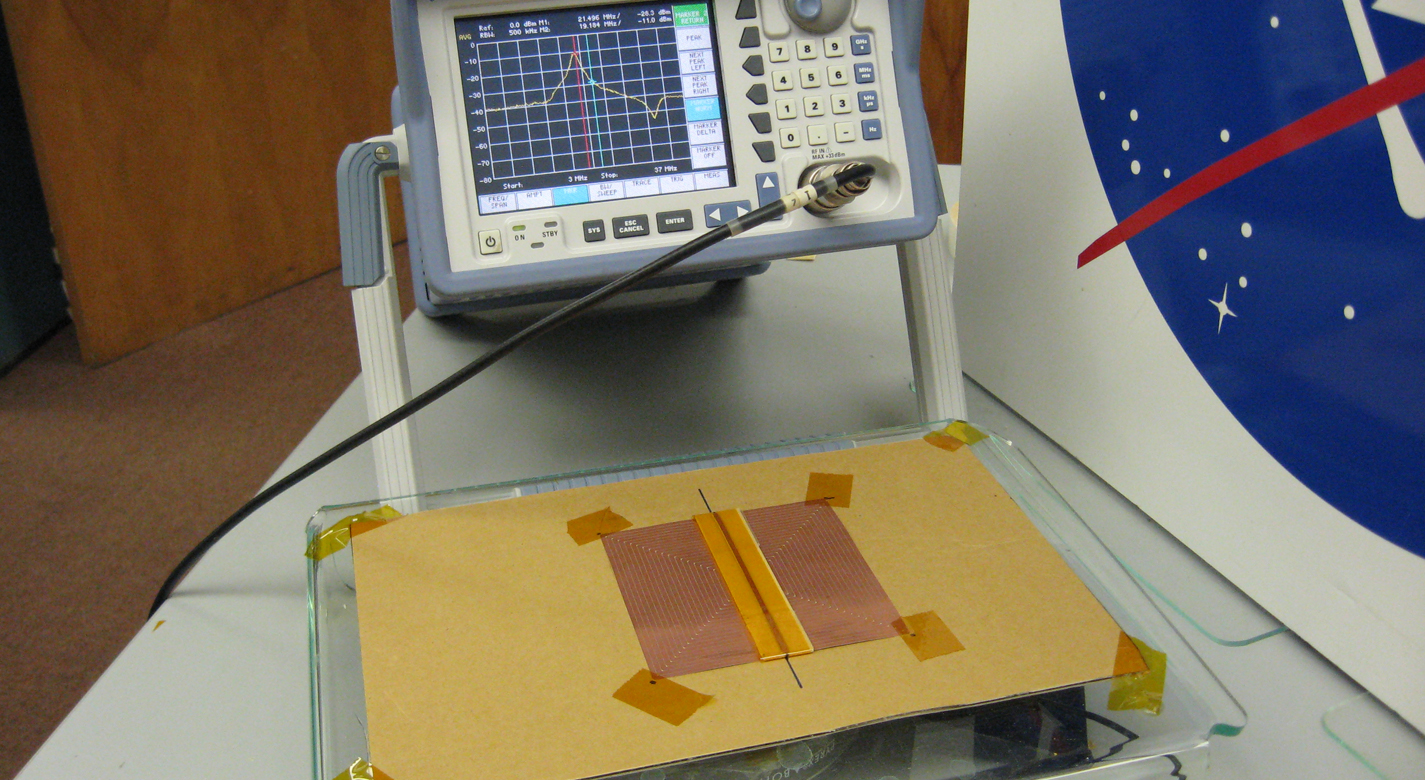Wireless Temperature Sensor Having No Electrical Connections
sensors
Wireless Temperature Sensor Having No Electrical Connections (LAR-TOPS-193)
Robust, flexible, wireless temperature sensor based on SansEC
Overview
NASA Langley Research Center has developed a robust, wireless temperature sensor that does not require an electrical connection. The temperature sensor is built on NASA's SansEC sensor platform, which takes advantage of measuring dielectric changes. The temperature sensor is damage tolerant, wireless, flexible, precise, and inexpensive. One promising application is for tire temperature sensors.
The Technology
This technology is a new sensor made up of dielectric materials tuned to accurately measure a variable and wide range of temperatures. The sensor is wireless and is powered by an external magnetic field. As the temperature changes, the dielectric material changes its signature magnetic response and the change is detected by a magnetic field response sensor. Applications for this technology are temperature sensors for non-conductive surfaces where the conditions or operations require a robust and wireless sensor.


Benefits
- Damage tolerant - As an open circuit sensor, it can sustain damage and still operate well
- Wireless - Because it is wireless, it can be used in places where wires are an impediment, like with rotating tires and turbines
- Flexible - Sensor is made of flexible materials that can be cut or scored to fit curved surfaces
- Wide Temperature Range - The temperature range detected is tunable based on the choice of dielectric materials
- Inexpensive - Compared to many other temperature sensors, it is inexpensive to make and easy to install
Applications
- Aerospace
- Automotive
- Food Processing
- Medical
Technology Details
sensors
LAR-TOPS-193
LAR-18016-1
LAR-17747-1-CON
LAR-17747-2-CON
Similar Results

Thin Film Sensor for Ultra High-Temp Measurement
The thin film sensor’s principal advantage lies in its potential to take high frequency temperature measurements from the surface of a reentering spacecraft while simultaneously withstanding the high temperature and oxidizing environment encountered. This data provides engineers with operational phase measurements used to refine the spacecraft’s operational envelope and track flight hardware behavior in addition to providing high frequency temperature measurements that can inform the physics of a boundary layer.
Mismatches in coefficients of thermal expansion (CTE) are expected in TPS-based sensor applications because the metallic materials used for temperature sensing have thermal expansion rates that differ from the rates of the substrate and coating materials in the TPS. At high temperatures during reentry, this mismatch in CTE can create a significant strain differential between the metallic sensor, sensor leads, and the materials to which the sensor and leads are bonded.
High frequency response temperature measurements on the surface of entry spacecraft are not currently possible above ~700 F with existing measurement capabilities. This shortcoming is primarily due to the need for robust sensor behavior at temperatures of several thousand degrees F. The sensor design of this technology preserves the integrity of sensor components while enhancing its high temperature functionality.
The thin film temperature sensor has a technology readiness level (TRL) 5 (Component and/or breadboard validation in relevant environment) and is now available for patent licensing. Please note that NASA does not manufacture products itself for commercial sale.

Wireless Electrical Devices Using Floating Electrodes
The technology presents a fundamental change in the way electrical devices are designed, using an open circuit in conjunction with a floating electrode, or an electrically conductive object not connected to anything by wires, and powered through a wireless device. This system uses inductor-capacitor thin-film open circuit technology. It consists of a uniquely designed, electrically conductive geometric pattern that stores energy in both electric and magnetic fields, along with a floating electrode in proximity to the open circuit. When wirelessly pulsed from the handheld data acquisition system (U.S. Patent Number 7,159,774, Magnetic Field Response Measurement Acquisition System), the system becomes electrically active and develops a capacitance between the two circuit surfaces. The result is a device that acts as a parallel plate capacitor without electrical connections.

Polymer Electrolyte-Based Ambient Temperature Oxygen Microsensor
Conventional ambient-temperature oxygen sensors are limited in various ways: optically based sensors can be expensive and challenging to manufacture; electrochemical cells with liquid electrolytes can have limited lifetimes and become leak sources; and both types of sensors are difficult to miniaturize. These problems are addressed with Glenn's novel ambient temperature oxygen microsensor, which is based on a Nafiontm polymer electrolyte, microfabricated using thin-film technologies. In the past, one drawback of Nafiontm film has been that it can lose conductivity when the moisture content in the film is too low, potentially affecting sensor operation. Glenn researchers devised a method to use certain salts to hold water molecules in the Nafiontm film structure at room temperature. The presence of these salts provides extra sites in the film to promote proton (H+) mobility, thus improving film conductivity and overall sensor performance, particularly in arid and high-temperature environments.
The innovative use of metal/metal oxide as the reference electrode enables miniaturization by eliminating the reference gas and sealing the reference electrode. The combination of interdigitized electrodes with the unique metal/metal oxide reference electrode permits sensor operation in either potentiometric or amperometric mode, as appropriate. In potentiometric mode, which measures voltage differences between working and reference electrodes in different gases, the voltage differences can be monitored with a voltmeter; however, the sensor itself does not need a power source. In room-temperature testing, the sensor achieved repeatable responses to 21 percent oxygen in nitrogen (using nitrogen as a baseline gas), and also detected oxygen from 7 to 21 percent, making Glenn's breakthrough technology usable for personal health monitoring as well as fire detection, fuel-leak detection, and environmental monitoring.

Packaging for SiC Sensors and Electronics
Prior approaches to bonding a SiC sensor and a SiC cover member relied on either electrostatic bonding or direct bonding using glass frits. The problem with the former is that its relatively weak bond strength may lead to debonding during thermal cycling, while the latter requires the creation of apertures that can allow sealant to leak. Glenn's innovation uses NASA's microelectromechanical system direct chip attach (MEMS-DCA) technology that can be bulk-manufactured to reduce sensor costs. The MEMS-DCA process allows a direct connection to be made between chip and pins, thereby eliminating wire bonding. Sensors and electronics are attached in a single-stage process to a multifunctional package, which, unlike previous systems, can be directly inserted into the housing. Additional thick pins within the electrical outlet allow the package to be connected to external circuitry. Furthermore, because the top and bottom substrates' thermomechanical properties are similar to that of the sensors, the problem of mismatch in the coefficient of thermal expansion is significantly reduced, minimizing thermal cycling and component fatigue. By protecting sensors and electronics in temperatures up to 600°C, approximately twice what has previously been achievable, Glenn's innovation enables SiC components to realize one of their most exciting possibilities - direct placement within high-temperature environments.
Wireless Sensor for Pharmaceutical Packaging and Monitoring Applications
The SansEC sensor is an electrically open circuit without electrical connections. Having a device without circuits eliminates a common failure source of electrical systems. It consists of a uniquely designed thin-film electrically conductive geometric pattern that stores energy in both electric and magnetic fields. When wirelessly interrogated from the portable data acquisition system, the sensor becomes electrically active and emits a wireless response. The magnetic field response attributes of frequency, amplitude, and bandwidth of the inductor correspond to the physical property states measured by the sensor. Container damage, temperature, spoilage, or substance level is detected by changes in resonant frequency read by the accompanying magnetic
field data acquisition system. A unique feature of the sensor is its ability to measure more than one physical attribute at the same time. In addition, by eliminating electrical connections, damage to any area of the sensor will not prevent it from being powered or interrogated.



